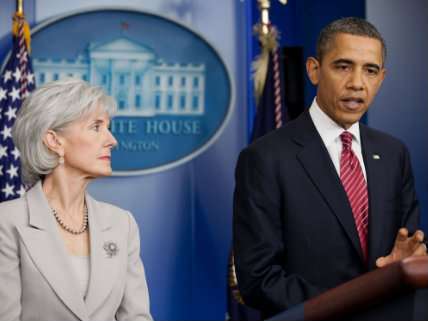6 Big Unanswered Questions About Obamacare

Obamacare supporters are taking a bit of a victory lap today after yesterday's administration announcement that six million people have signed up for private plans under the law, equaling the revised projection put out by the Congressional Budget Office after the botched launch of the exchanges last October.
It's a weak cause for celebration, given that success, according to Health and Human Services Secretary Kathleen Sebelius, was originally "at least" seven million people getting covered under the law by the end of March. And as an Obamacare factoid, the six million sign-ups figure just doesn't tell us all that much about whether and how the law is working. There are still a lot of major unanswered questions about the law and its future.
1. How many people have actually enrolled? This is the big one. I've written about it a lot for a reason: The headline sign-up numbers are often described as enrollment numbers. They're not. A significant portion of people who sign up for coverage aren't paying their first month's premium, and are therefore never enrolled. In California, it's about 15 percent of sign-ups. In Wisconsin and Georgia, it's closer to 20 percent. In Nevada and Vermont, it's more than 30 percent. Until we know how many people have paid, we won't know how many people got covered.
2. What percentage of those who are enrolled are between the ages of 18 and 34? After the launch of the exchanges last October, the White House repeatedly emphasized that they were less focused on the total number of enrollments and more concerned with the demographic mix—specifically, the number of young adults signing up. Young adults tend to be less expensive to insure, so their premiums are needed to balance out the costs of the older, more expensive enrollees. Early on the administration had been clear that it was aiming for 40 percent of enrollees to be in the youngest cohort. But so far, the administration's reports have indicated that only about 25 percent of sign-ups are young adults.
3. Are the young people who are enrolling actually healthy? This one will be hard to answer, but it's important. In the population as a whole, young adults tend to be healthier, and therefore less inclined to use lots of health care services, than their elders. But the characteristics of the 6 million or so folks who end up in the exchange population may not mirror the population as a whole. It's entirely possible that the young adults who do end up signing up will be sicker, on average, than their peers. If so, that will complicate premium pricing down the road.
4. What are the sign-up totals, demographic breakdowns, and overall health of the individual state markets? The headline national numbers only tell part of the story. By the middle of this month, 13 states had exceeded initial enrollment projections, according to a count by Philip Klein of The Washington Examiner. But another 12 states were at less than half their projected sign-ups, and 24 were at less than two-thirds of sign-up expectations. What this means is that Obamacare is going to look very different depending on what state you live in. Some states will meet or beat enrollment expectations and presumably end up with viable insurance markets in the process. But others will have low enrollment totals and bad demographic mixes, and are likely to face higher premiums and fewer plan choices as a result.
5. How many of the people enrolled under the law were previously uninsured? And how many of them were previously among the long-term uninsured? Even once we find out how many of the people who have signed up for coverage have actually enrolled, we still won't know the answer to another big question: How many of the enrollees were previously uninsured? Surveys and word from insurance industry insiders suggest that anywhere from a quarter to half of enrollments were previously uninsured—meaning it's possible that the majority of enrollments are for people who were already covered before the law's insurance expansion took effect. Moreover, when trying to figure this out, it's worth thinking about who counts as previously uninsured: Many counts of the nation's uninsured population count people who went without insurance for a few months, often while transitioning between jobs. But it's the long-term uninsured—those who have gone years without coverage—we should be focusing on.
6. What will premiums look like next year? This matters both for the politics of the law and for its success as a policy mechanism. President Obama initially sold the health care overhaul as a way to reduce premiums, but recently the administration has trimmed back its promises, saying instead that premiums will still rise, just not as fast as prior to the law. But there are early rumbles from insurers suggesting that, when they set rates for next year, premiums could jump dramatically, with some warning that rates could double, or more. Because of the state-by-state nature of Obamacare's insurance markets, those effects won't be felt evenly. But if big hikes do appear in many markets, then you have to wonder: How many people will want to stay with their current plans? And what will this do to the already weak political support for the law?


Show Comments (86)